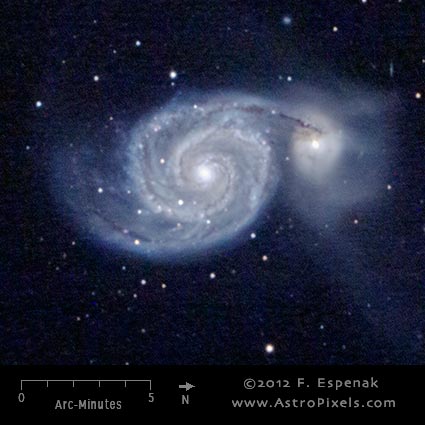
M51 - Whirlpool Galaxy
Messier 51 or M51 (also designated NGC 5194/5) is a spiral galaxy in the constellation Canes Venatici. It has an apparent visual magnitude of 8.4 and its angular diameter is 11x7 arc-minutes. M51 lies at an estimated distance of 37 million light years. The Equinox 2000 coordinates are RA= 13h 30m, Dec= +47° 11´ which makes M51 best seen during the spring. The Messier Spring Star Chart shows the position of all Messier objects visible during that season. As one of the more famous objects in the Messier Catalog, it is commonly known as the Whirlpool Galaxy.
The image above shows the uncropped view of M51 and its companion galaxy NGC 5195 through the ASA N12 Corrected Newtonian Astrograph (North is to the right). A 2x enlargement of this image appears to the right.
For wider view of this galaxy using the Takahashi E-180 Astrograph, see M51 (TAK E-180) .
The Whirlpool Galaxy was discovered by Messier in 1773 and is one of the best known spiral galaxies. It was the first such object in which the spiral structure was observed by Lord Rosse in 1845. Its unusually pronounced spiral structure is due in part to the strong gravitational interaction with its companion galaxy NGC 5195. According to Stoyan et al. (2010), the distance of M51 is 26.8 million light years and its diameter is 87,000 light years.
For more information, see the Messier Catalog as well as specific entries for M51 in Wikipedia and SEDS.
Messier's Description of M51
January 11, 1774
`Very faint nebula, without stars, near the eye of the Northern Greyhound
[hunting dog], below the star Eta of 2nd magnitude of the tail of Ursa Major:
M. Messier discovered this nebula on October 13, 1773, while he was watching
the comet visible at that time. One cannot see this nebula without difficulties
with an simple refractor of 3.5 feet: Near it is a star of 8th magnitude.
M. Messier reported its position on the Chart of the Comet observed in 1773
and 1774. Memoirs of the Academy 1774, plate III.
It is double, each has a bright center, which are separated 4'35".
The two "atmospheres" touch each other, the one is even fainter than the
other. Reobserved several times.'
Technical Details
- Object: M51
- Other Names: NGC 5194/5, Whirlpool Galaxy
- Object Type: spiral galaxy
- Object Data: Apparent Magnitude = 8.4, Angular Size = 11x7 arc-minutes
- Object Position (Equinox 2000): RA= 13h 30m, Dec= +47° 11´, Constellation = Canes Venatici
- Date/Time: 2012 Mar 23 at 05:29 UTC
- Location: Bifrost Astronomical Observatory, Portal, AZ
- Mount: Astro-Physics 1200GTO
- Telescope: ASA N12 Corrected Newtonian Astrograph
- Camera: Canon EOS 550D (Rebel T2i) (modified with a Baader UV/IR filter)
- Field of View: 71.0 x 47.4 arc-minutes at 0.82 arc-sec/pixel (web version: 4.6 arc-sec/pixel)
- Exposure: 8 x 420s, f/3.6, ISO 800
- File Name: M51-A01w.jpg
- Processing (Adobe Camera Raw): Flat Field Subtraction, Noise Reduction, White Balance
- Processing (Photoshop CS5): Average Images, Curves, Noise Reduction, High Pass Filter, Unsharp Mask
- Original Image Size: 3454 × 5179 pixels (17.9 MP); 11.5" x 17.3" @ 300 dpi
- Rights: Copyright 2012 by Fred Espenak. All Rights Reserved. See: Image Licensing.
